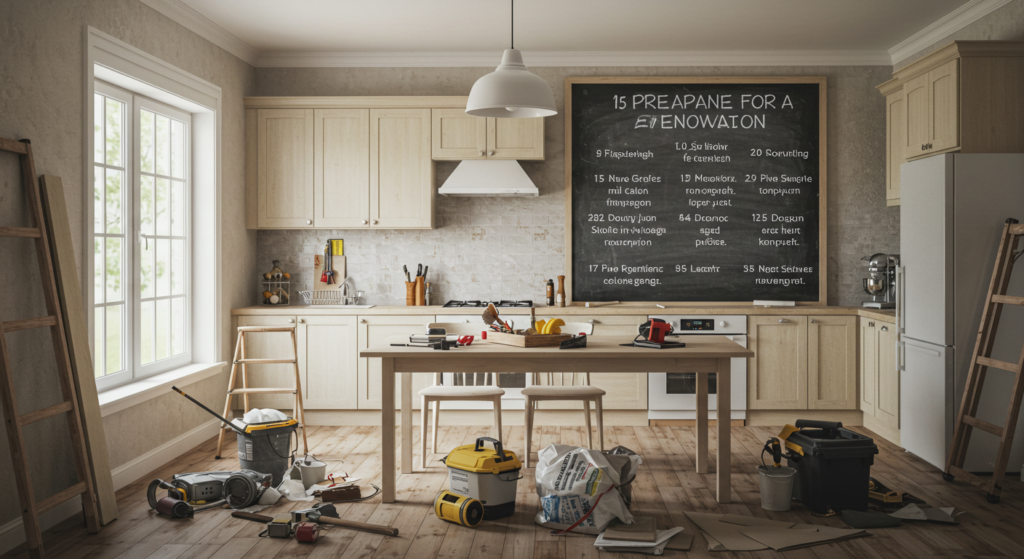In this blog we have mentioned the realistic sites with their proven track records. So you may learn from this post the depth details of the kitchen renovation with their installation guide. In this blog post we have mentioned the 15 ways of your kitchen improving so you can do it according to your desires.
1. Set a realistic budget
Contents
- 1 1. Set a realistic budget
- 2 2. Define your scope and goals
- 3 3. Plan the timeline
- 4 4. Obtain permits and approvals
- 5 5. Declutter & clear the kitchen
- 6 6. Set up a temporary kitchen
- 7 7. Plan meals ahead
- 8 8. Disconnect and relocate appliances safely
- 9 9. Protect flooring & pathways
- 10 10. Consider pets & family logistics
- 11 11. Communicate with neighbors
- 12 12. Hire and vet your professionals
- 13 13. Ensure your design is efficient
- 14 14. Utilize color‑coded packing & labeling
- 15 15. Plan for a 6–8 week timeline
- 16 Common Mistakes & How to Avoid Them
- 17 Emerging Trends for 2025
- 18 Further Reading & Tools
- 19 Conclusion
- According to Angi, the average cost for a full kitchen remodel in 2025 is $27,013 (range: $14,592–$41,595) houghtoncontracting.com+15Angi+15modernkitchenva.com+15.
- Midrange data from NerdWallet shows minor remodels averaging around $27 k, while high-end projects can top $150 k NerdWallet.
- Plan for 10–20% extra to cover surprises like outdated wiring or uneven floors The Spruce.
2. Define your scope and goals
- Minor refresh ($10–20 k): paint cabinets, update backsplash, new faucet millersresidential.com+15Home Advisor+15HomeGuide+15.
- Major renovation ($20–65 k): semi‑custom cabinets, flooring, appliances, possible layout change Home Advisor+5Angi+5NerdWallet+5.
- Full luxury remodel ($65–150 k+): gut renovation, custom cabinetry, plumbing/electrical rerouting Build Design Center Kitchen & Bath+1NerdWallet+1.
3. Plan the timeline
- Complete remodel typically takes 8–12 weeks (~2–3 months) millersresidential.com+1kriskonstruction.com+1.
- Timeline breakdown:
- Design/planning: 2–4 weeks
- Permits: 1–2 weeks
- Demolition: 3–7 days
- Rough‑ins: ~1 week
- Cabinet & countertop install: 2–4 weeks
- Final fixtures & cleanup: ~1 week
revive.realestate+2millersresidential.com+2Build Design Center Kitchen & Bath+2
- Design/planning: 2–4 weeks
- Build in padding—permits, shipping delays, and contractor availability can easily add 20–30% buffer Better Homes & Gardens.
4. Obtain permits and approvals
- Necessary for structural changes, plumbing, or electrical rerouting HomeGuide.
- Factor 1–2 weeks (or more) for approval in your schedule.
5. Declutter & clear the kitchen
- Remove dishes, small appliances, and décor.
- Label and donate unused items.
- Store essentials in color‑coded boxes for easy unpacking.
6. Set up a temporary kitchen
- Create a makeshift cooking space: microwave, mini-fridge, disposable plates, cutlery, and cooking utensils.
- Options include outdoor grilling or dining out locally to minimize disruption.
7. Plan meals ahead
- Map out weekly meals with shelf‑stable ingredients.
- Stock easy-to-prepare staples like pasta, canned soup, and granola.
8. Disconnect and relocate appliances safely
- Hire professionals to disconnect gas, water, and electrical.
- Use proper plugs/caps and store appliances securely away from dust and moisture.
9. Protect flooring & pathways
- Seal off other rooms with dust-proof plastic barriers.
- Lay protective coverings on floors, especially in high-traffic zones.
10. Consider pets & family logistics
- Pets may need temporary relocation to reduce stress and noise.
- If necessary, plan a family vacation or coordinate with extended family.
11. Communicate with neighbors
- Inform them of renovation dates and likely noise levels.
- Share contact info for your contractor in case issues arise.
12. Hire and vet your professionals
- Speak to general contractors, interior designers, cabinet installers, plumbers, and electricians.
- Use NKBA, HomeAdvisor, Angi, and Houzz to verify credentials, reviews, and completed projects.
- Request multiple quotes and check past customer satisfaction.
13. Ensure your design is efficient
- Use kitchen-planning tools like IKEA Kitchen Planner or Houzz for layout optimization.
- Prioritize work triangle flow, smart storage, and accessibility.
14. Utilize color‑coded packing & labeling
- Store items like silverware, pots, and pantry essentials in distinct colors.
- Helps expedite unpacking when your renovation wraps up.
15. Plan for a 6–8 week timeline
- Minor gut renovation: 6 weeks; major or full remodel: up to 8 weeks or longer NerdWalletU.S. News Real Estate+15kriskonstruction.com+15Axios+15Angi.
- Use weekly check‑ins with your contractor, plus a penalty clause for delays Better Homes & Gardens.
Common Mistakes & How to Avoid Them
| Pitfall | Solution |
| No contingency fund | Add 10–20% extra to budget HomeGuide+15The Spruce+15commonwealthcontracts.com+15 |
| Skipping permits | Confirm permit needs early and apply promptly |
| Changing scope mid‑stream | Finalize design first; don’t add last‑minute “must‑haves” |
| Poor communication | Weekly site visits; document progress |
| Over-customization | Keep resale value in mind—transitional styles remain strong |
Emerging Trends for 2025
- Vinyl/resilient flooring is now the top choice over hardwood and tile Angi+15Real Simple+15The Times+15.
- Transitional kitchens (blending modern/traditional) are leading styles Daily Telegraph+11Real Simple+11commonwealthcontracts.com+11.
- Black countertops and glass-front accent cabinets are growing in popularity.
Further Reading & Tools
- Angi & HomeAdvisor cost guides NerdWallet+9commonwealthcontracts.com+9millersresidential.com+9Build Design Center Kitchen & Bath+7Home Advisor+7NerdWallet+7U.S. News Real Estate+3HomeGuide+3kriskonstruction.com+3NerdWalletHomeGuide+6Better Homes & Gardens+6Build Design Center Kitchen & Bath+6Build Design Center Kitchen & Bath+5Complete Construction Utah+5millersresidential.com+5HomeLight+2Angi+2U.S. News Real Estate+2
- NKBA for professional standards
- IKEA Kitchen Planner & Houzz design tools
- BHG renovation timeline tips kriskonstruction.com+4Better Homes & Gardens+4revive.realestate+4
Conclusion
A successful kitchen renovation hinges on planning, realistic budgeting, good communication, and contingency readiness. Cover essentials like permits, appliances, dust control, and temporary cooking setups early. With today’s popular trends—transitional design, vinyl flooring, and accent cabinets—you’ll create a space that’s not only beautiful and functional but also stays on budget and schedule.

